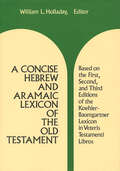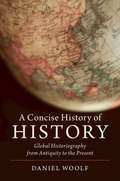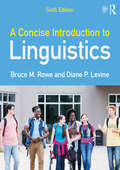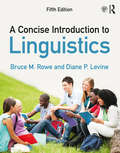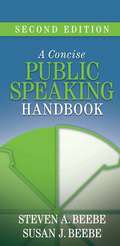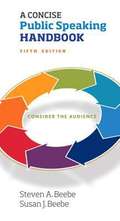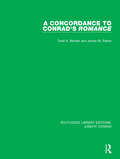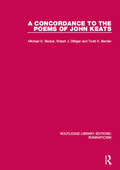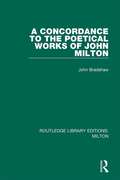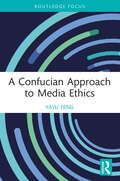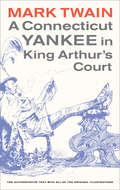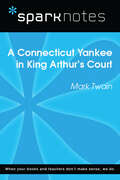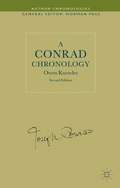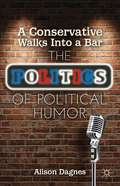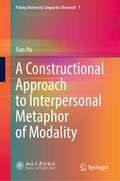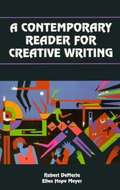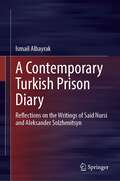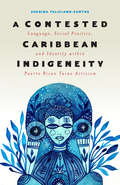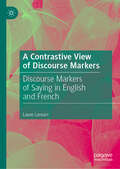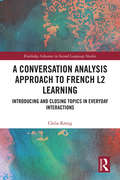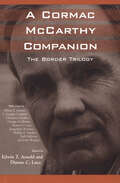- Table View
- List View
A Concise Hebrew and Aramaic Lexicon of the Old Testament
by William L. HolladayBased on the First, Second, and Third Editions of the Koehler-Baumgartner Lexicon in Veteris Testamenti Libros, this abridgment--which eliminates bibliographical references and technical information intended for specialists and judiciously trims biblical citations--provides everything the student needs to translate an Old Testament passage.
A Concise History of History: Global Historiography from Antiquity to the Present (Cambridge Concise Histories Ser.)
by Daniel WoolfThis short history of history is an ideal introduction for those studying or teaching the subject as part of courses on the historian's craft, historical theory and method, and historiography. Spanning the earliest known forms of historical writing in the ancient Near East right through to the present and covering developments in Europe, Asia, Africa and the Americas, it also touches on the latest topics and debates in the field, such as 'Big History', 'Deep History' and the impact of the electronic age. It features timelines listing major dynasties or regimes throughout the world alongside historiographical developments; guides to key thinkers and seminal historical works; further reading; a glossary of terms; and sample questions to promote further debate at the end of each chapter. This is a truly global account of the process of progressive intercultural contact that led to the hegemony of Western historiographical methods.
A Concise Introduction to Linguistics
by Bruce M. Rowe Diane P. LevineNow in its sixth edition, A Concise Introduction to Linguistics provides students with a detailed introduction to the core concepts of language as it relates to culture. The textbook includes a focus on linguistic anthropology, unpacking the main contributions of linguistics to the study of human communication and culture. Aimed at the general education student, the textbook also provides anthropology, linguistics, and English majors with the resources needed to pursue advanced courses in this area. Written in an accessible manner that does not assume previous knowledge of linguistics, this new edition contains expanded discussions on linguistic anthropology, sociolinguistics (including an expanded section on trans and nonbinary language), and pragmatics. The textbook incorporates a robust set of pedagogical features, including marginal definitions, a substantial glossary, chapter summaries, and learning exercises. Brand new to this edition are a full International Phonetic Alphabet chart, new exercises with languages other than English, and new illustrations.
A Concise Introduction to Linguistics (Myanthrokit Ser.)
by Bruce M. Rowe Diane P. LevineNow in its fifth edition, A Concise Introduction to Linguistics provides students with a detailed introduction to the core concepts of language as it relates to culture. The textbook includes a focus on linguistic anthropology, unpacking the main contributions of linguistics to the study of human communication and culture. Aimed at the general education student, the textbook also provides anthropology, linguistics, and English majors with the resources needed to pursue advanced courses in this area. Written in an accessible manner that does not assume previous knowledge of linguistics, this new edition contains expanded discussions on linguistic anthropology, sociolinguistics (including a section on gender and language), and pragmatics. The textbook incorporates a robust set of pedagogical features including marginal definitions, a substantial glossary, chapter summaries, and learning exercises. Brand new to this edition are suggested reading lists at the end of every chapter, and recommended websites and apps to further aid students in their study.
A Concise Introduction to Syntactic Theory: The Government-Binding Approach
by Elizabeth A. CowperThis textbook is intended to give students a quick start in using theory to address syntactic questions. At each stage, Cowper is careful to introduce a theoretical apparatus that is no more complex than is required to deal with the phenomenon under consideration. Comprehensive and up-to-date, this accessible volume will also provide an excellent refresher for linguists returning to the study of Government-Binding theory. "Cowper exhibits the analytical devices of current principles-and-parameters approaches, takes readers carefully through the central elements of grammatical theory (including very recent work), and ushers them selectively into the technical literature. . . . A serious introduction for those who want to know the nuts and bolts of syntactic theory and to see why linguists are so excited these days. "—David Lightfoot, University of Maryland "An excellent short introduction to the Government and Binding model of syntactic theory. . . . Cowper's work succeeds in teaching syntactic argumentation and in showing the conceptual reasons behind specific proposals in modern syntactic theory. "—Jaklin Kornfilt, Syracuse University
A Concise Introduction to Syntactic Theory: The Government-Binding Approach
by Elizabeth A. CowperThis textbook is intended to give students a quick start in using theory to address syntactic questions. At each stage, Cowper is careful to introduce a theoretical apparatus that is no more complex than is required to deal with the phenomenon under consideration. Comprehensive and up-to-date, this accessible volume will also provide an excellent refresher for linguists returning to the study of Government-Binding theory. "Cowper exhibits the analytical devices of current principles-and-parameters approaches, takes readers carefully through the central elements of grammatical theory (including very recent work), and ushers them selectively into the technical literature. . . . A serious introduction for those who want to know the nuts and bolts of syntactic theory and to see why linguists are so excited these days."—David Lightfoot, University of Maryland "An excellent short introduction to the Government and Binding model of syntactic theory. . . . Cowper's work succeeds in teaching syntactic argumentation and in showing the conceptual reasons behind specific proposals in modern syntactic theory."—Jaklin Kornfilt, Syracuse University
A Concise Public Speaking Handbook (2nd edition)
by Susan J. Beebe Steven A. BeebeThis book is a handbook about how to prepare, develop, and deliver a speech. Both theoretical and concrete topics are explored and the authors describe in much detail the use of technology. Specifically, the authors discuss such aspects of the speech preparation, development, and delivery process as the context and the style and type of speech. Besides these traditional aspects of speech preparation and development, the authors discuss the impact of the audience upon the speakers as they engage in this ongoing speech process, the attitudes, emotional states, and values of the speakers, and the quality of the speech in terms of articulation and content. In order to insure reader comprehension, every chapter contains lists of items that can be checked off as each step in the process of preparing a speech is completed. Also, each chapter contains a feature called a brief ethics section which focuses on the ethical consideration in the speech development, preparation, and delivery process. In short, all aspects of the speech process are covered.
A Concise Public Speaking Handbook (5th Edition)
by Susan J. Beebe Steven A. BeebeA Concise Public Speaking Handbook emphasizes the importance of analyzing and considering the audience at every point in the speech-making process. Using a concise reference format that facilitates quick and easy access to key information, authors Steven and Susan Beebe present a balance of theory and practice to guide students on how to enhance their public speaking skills. By focusing student attention on the dynamics of diverse audiences, ethics, and communication apprehension, the text narrows the gap between the classroom and the real world. The Fifth Edition includes fresh examples throughout to ensure that content is relatable and engaging for students.
A Concise Survey of French Literature
by Germaine MasonAn overview of French literature as it evolved from the Middle Ages to the mid-twentieth century. In this compact yet wide-ranging volume, the many aspects of French literature and the different tendencies of successive schools are shown in the light of contemporaneous political and artistic developments. A Concise Survey of French Literature explores the relationship between literature and the evolution of French thought, deeply concerned, as it is, with the problems of human life and destiny. It also serves as an excellent reference for any student of French literature.
A Concordance to Conrad's Romance (Routledge Library Editions: Joseph Conrad)
by Todd K. Bender James W. ParinsOriginally published in 1985, this volume follows others in the series. An alphabetical frequency table lists all the words indexed with the frequency of their appearance in the field of reference. There is also a table arranged by descending frequency. The verbal index lists the location of the context of each word in the field of reference. This volume is part of a series which produced verbal indexes, concordances, and related data for all of Conrad’s works.
A Concordance to the Poems of John Keats (Routledge Library Editions: Romanticism #3)
by Todd K. Bender Michael G. Becker Robert J. DilliganFirst published in 1981. A Concordance to the Poems of John Keats intended to provide the user with a volume suitable to the varying and increasingly specialised interests of scholarship. This title offers a high degree of inclusiveness that attends to the poems and plays, the emended and authoritative headings, and virtually all of the variant readings considered substantive in the riches of the Keats manuscript materials. This title will be of interest to students of literature.
A Concordance to the Poetical Works of John Milton (Routledge Library Editions: Milton #3)
by John BradshawFirst published in 1894. This Concordance to the Poetical Works of John Milton includes all of Milton’s poems, excluding the Psalms and the Translations in the prose works; and all of the words are given with the exception of some of the pronouns, conjunctions, adverbs and prepositions; but any of these used peculiarly are given. It is hoped that the work will be found useful not only by the student of Milton but by the grammarian and the philologist.
A Confession and Other Religious Writings
by Leo Tolstoy Jane KentishDescribing Tolstoy's crisis of depression and estrangement from the world, A Confession(1879) is an autobiographical work of exceptional emotional honesty. By the time he was fifty, Tolstoy had already written the novels that would assure him of literary immortality; he had a wife, a large estate and numerous children; he was 'a happy man' and in good health - yet life had lost its meaning. In this poignant confessional fragment, he records a period of his life when he began to turn away from fiction and aesthetics, and to search instead for 'a practical religion not promising future bliss but giving bliss on earth'. His searingly honest search for spiritual fulfilment also inspires the three other works collected here: Religion and Morality(1893), What is Religionand of What Does Its Essence Consist?(1902) and The Law of Love and the Law of Violence(1908).
A Confucian Approach to Media Ethics (Routledge Focus on Communication Studies)
by Yayu FengA Confucian Approach to Media Ethics offers a comprehensive theorization of an approach to media ethics based on the moral philosophy that originated from China and that profoundly influenced East Asian countries.This book engages with foundational concepts from Confucian ethics and explicates a new framework that can be used for guiding media practices, as well as media ethics research and teaching. It suggests that the Confucian ideals of He (harmony), Zhong (equilibrium), and the notion of Junzi can be applied to guide intercultural media practices, and sets out a fresh model for ethics education centered on Xiuji (self-cultivation) that is different from the training-based and decision-making-centered model prevalent in the Western classrooms. This is also a framework that emphasizes both individual moral growth and the moral character of the broader professional community.Filling a gap in the conversation between Eastern and Western approaches to media ethics, this innovative and important volume will offer new perspectives to students and scholars of media ethics, communication studies, and comparative philosophy.
A Connecticut Yankee in King Arthur's Court
by Mark Twain Daniel Carter Beard Bernard L. SteinWhenA Connecticut Yankee at King Arthur's Courtwas published in 1889, Mark Twain was undergoing a series of personal and professional crises. In his Introduction, M. Thomas Inge shows how what began as a literary burlesque of British chivalry and culture developed to tragedy and into a novel that remains a major literary and cultural text for generations of new readers. This edition reproduces a number of the original drawings by Dan Beard, of whom Twain said "He not only illustrates the text but he illustrates my thoughts. "
A Connecticut Yankee in King Arthur's Court (SparkNotes Literature Guide Series)
by SparkNotesA Connecticut Yankee in King Arthur's Court (SparkNotes Literature Guide) by Mark Twain Making the reading experience fun! Created by Harvard students for students everywhere, SparkNotes is a new breed of study guide: smarter, better, faster.Geared to what today's students need to know, SparkNotes provides:chapter-by-chapter analysis explanations of key themes, motifs, and symbols a review quiz and essay topics Lively and accessible, these guides are perfect for late-night studying and writing papers.
A Conrad Chronology
by Owen KnowlesThis chronology is designed to provide a digest of Conrad's life as it develops from year to year. It is written as a series of diary or chronicle entries and thus caters for the reader who may wish to check a single fact. The main contents are supplemented by a Who's Who and indexes which provide easy access to a wider range of information.
A Conservative Walks Into a Bar
by Alison DagnesConservative critics argue that modern political satire, in the age of The Daily Show, has a liberal bias. A quick review of the humor landscape shows that there are very few conservative political satirists, and using personal interviews with political humorists this book explains why. The book explores the history of satire, the comedy profession, and the nature of satire itself to examine why there is an ideological imbalance in political humor and it explores the consequences of this disparity. This book will appeal to Daily Show and Colbert fans, political junkies, and anyone interested in the intersection of politics and media.
A Constructional Approach to Interpersonal Metaphor of Modality (Peking University Linguistics Research #7)
by Jian HuThis book is a current and comprehensive study that incorporates constructional frameworks to inquire grammatical metaphor of modality (MM) for more adequate description and explanation of grammatical metaphor. It conducts semantic analysis of MM via a refined cognitive model and investigation of its lexicogrammatical forms from corpus-based constructional approach. The result is a reliable and systemic record of MM in real use, coupled with theoretical refinement from a cognitive perspective to illuminate its ‘metaphoricity’ motivation. The constructional approach and methodology exemplified in this book provide fresh insights, rich data, and a feasible solution for the adequate description and explanation of grammatical metaphor phenomena and the form-meaning interactive complexity in modality.
A Contemporary Reader for Creative Writing
by Robert Demaria Ellen Hope MeyerThe purpose of this book is to provide readings for Creative Writing workshops. The short stories, poems, and plays included have been chosen because they illustrate certain specific aspects of the writer's craft.
A Contemporary Turkish Prison Diary: Reflections on the Writings of Said Nursi and Aleksander Solzhenitsyn
by Ismail AlbayrakThis book explores the religious experiences of two notable figures who endured severe trials under authoritarian regimes: Bediuzzaman Said Nursi (1877–1960) within the Islamic tradition, and Aleksander Solzhenitsyn (1918–2008) within the Russian Orthodox Christian tradition. Against the tumultuous backdrop of the twentieth century’s spiritual, social, political, and intellectual upheavals, both Nursi and Solzhenitsyn grappled with immense hardships because of their beliefs. Despite immense tribulations, both individuals demonstrated unwavering faith and resilience in the face of adversity, continuing their scholarly and literary activities. The current study centers on the dichotomy of spiritual confinement and expansiveness, illustrating how people can experience spiritual distress even without physical restraints. It explores the historical and conceptual aspects of imprisonment within Christian and Muslim perspectives, explores the reasons for Nursi and Solzhenitsyn's incarceration, examines their coping mechanisms in the face of hardship, and underscores the role of faith and spirituality. The author integrates personal experiences, particularly his own incarceration during the aftermath of the 2016 Turkish staged coup attempt, within the context of the narratives of Nursi and Solzhenitsyn. The book addresses court proceedings, release, departure from Turkey, and resettlement in Australia. Throughout, the author draws parallels between their own observations and those of Nursi and Solzhenitsyn, contributing to the broader discourse on individual spirituality and collective consciousness. The book offers insights into spiritual resilience in the face of adversity, utilizing the lives of these figures to illuminate shared human experiences. A unique collation of personal narration and scholarly reflection, it is relevant to academics and students in history, political science, sociology, Islamic and Middle Eastern studies, and to social scientists researchingthe phenomenon of exile and prison in different countries across the world. It also speaks to the work of activists and policymakers in human rights.
A Contested Caribbean Indigeneity: Language, Social Practice, and Identity within Puerto Rican Taíno Activism (Critical Caribbean Studies)
by Sherina Feliciano-SantosA Contested Caribbean Indigeneity is an in-depth analysis of the debates surrounding Taíno/Boricua activism in Puerto Rico and the Caribbean diaspora in New York City. Drawing on in-depth ethnographic research, media analysis, and historical documents, the book explores the varied experiences and motivations of Taíno/Boricua activists as well as the alternative fonts of authority they draw on to claim what is commonly thought to be an extinct ethnic category. It explores the historical and interactional challenges involved in claiming membership in, what for many Puerto Ricans, is an impossible affiliation. In focusing on Taíno/Boricua activism, the books aims to identify a critical space from which to analyze and decolonize ethnoracial ideologies of Puerto Ricanness, issues of class and education, Puerto Rican nationalisms and colonialisms, as well as important questions regarding narrative, historical memory, and belonging.
A Contrastive View of Discourse Markers: Discourse Markers of Saying in English and French
by Laure LansariThis book is a comparative corpus-based study of discourse markers based on verbs of saying in English and French. Based on a wide comparable web corpus, the book investigates how discourse markers work in discourse, and compares their differences of position, scope and collocations both cross-linguistically and within single languages. The author positions this study within the wider epistemological background of the French-speaking ‘enunciative’ tradition and the English-speaking ‘pragmatic’ tradition, and it will be of particular interest to students and scholars of semantics, pragmatics and contrastive linguistics.
A Conversation Analysis Approach to French L2 Learning: Introducing and Closing Topics in Everyday Interactions (Routledge Advances in Second Language Studies)
by Clelia KönigThis book offers a critical examination of second language (L2) learning outside institutional contexts, with a focus on the way second language learners introduce, close, and manage conversational topics in everyday settings. König adopts a Conversation Analysis for Second Language Acquisition (CA-SLA) approach in analyzing oral data from a longitudinal study of L2 learners of French, au pairs in Swiss families, over several years. With this approach the author presents insights into the ways in which L2 learners introduce and close conversational topics in ongoing conversations and how these strategies evolve over time, setting the stage for future research on this little documented process in second language acquisition. This volume contributes toward a greater understanding of L2 learning “in the wild,” making this key reading for students and researchers in second language acquisition, applied linguistics, and French language learning and teaching.
A Cormac McCarthy Companion: The Border Trilogy
by Edwin T. ArnoldWith essays by Edwin T. Arnold, J. Douglas Canfield, Christine Chollier, George Guillemin, Dianne C. Luce, Jacqueline Scoones, Phillip A. Snyder, Nell Sullivan, and John Wegner The completion of Cormac McCarthy's Border Trilogy--All the Pretty Horses (1992), The Crossing (1994), and Cities of the Plain (1998)--marked a major achievement in American literature. Only ten years earlier this now internationally acclaimed novelist had been called the best unknown writer in America. The trilogy is McCarthy's most ambitious project yet, composed at the height of his mature powers over a period of fifteen years. It is "a miracle in prose," as Robert Hass wrote of its middle volume, an unsentimental elegy for the lost world of the cowboy, the passing of the wilderness, and the fading innocence of post--World War II America. The trilogy is a literary accomplishment with wide appeal, for despite the challenging materials in each book, these volumes remained on bestseller lists for many weeks. This collection of essays is the first book to examine these novels as a trilogy, the first to read them as an integrated whole. Together these explorations of McCarthy's magnum opus serve as an ideal companion reader. Represented here are nine of the most notable Cormac McCarthy scholars, both American and European. Their essays provide a substantial exploration of the trilogy from different perspectives. Included are gender issues, eco-critical approaches, explications of the war or land history underlying the trilogy, studies of narrative voice, dreams, the cowboy tradition, and the pastoral tradition, and considerations of McCarthy's moral and spiritual outlook. These essays complement one another in highly provocative ways, prompting new appreciation of the complexity of McCarthy's work and the profundity of his vision.
